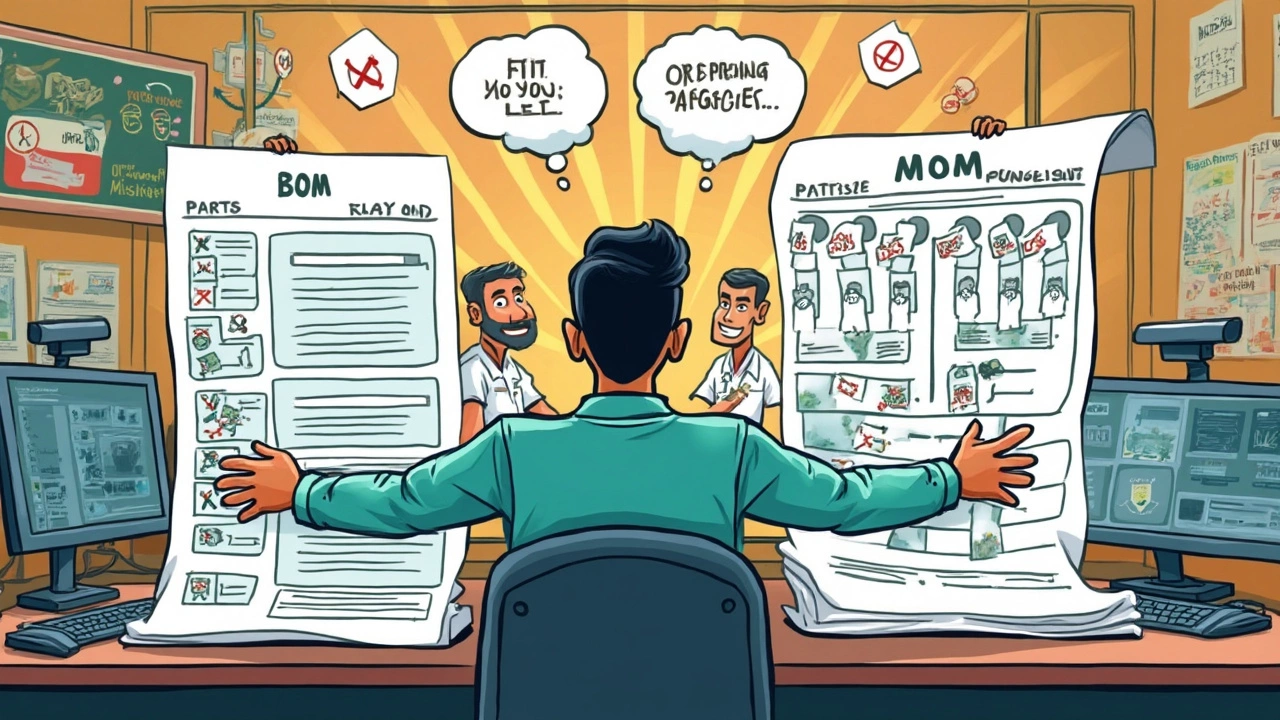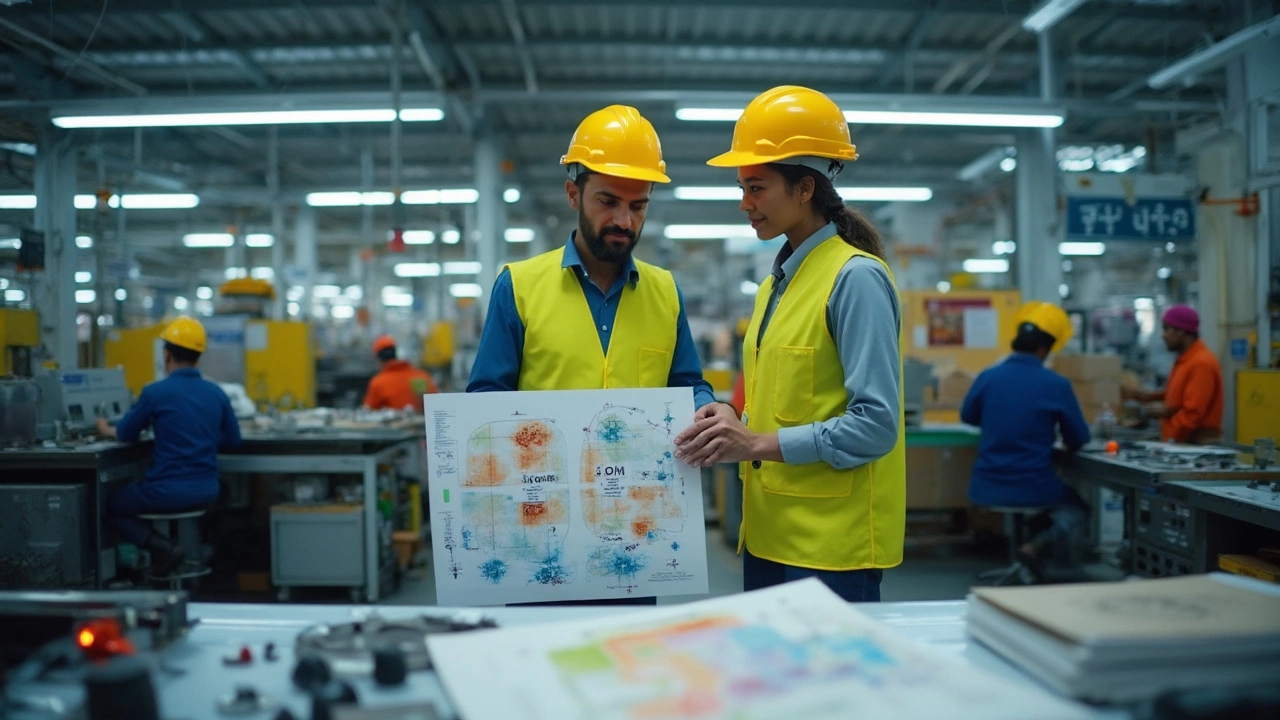Ever faced the mix-up between BOM and MOM and wondered if someone just messed up the spelling? It’s not a typo—they’re two totally different things, and screwing them up can throw a wrench in your whole manufacturing process.
If you’re dealing with government manufacturing schemes or even running your own factory, these two buzzwords keep popping up for a reason. BOM stands for Bill of Materials. Think of it as a master grocery list for your product—every screw, nut, and material needed before you even start making anything. MOM, on the other hand, isn’t about the shopping list—it’s about the recipe. MOM means Manufacturing or Method of Manufacturing, and it's basically the step-by-step instructions for putting all those parts together.
Here’s the catch: a solid BOM with a sloppy MOM means you have the parts but no clue how to assemble them. The opposite? You’ve got the best instructions in the world, but half your puzzle pieces are missing. Most production headaches trace back to ignoring one or blending the two together. So, understanding these differences isn’t just textbook stuff—it’s what keeps your assembly line moving and keeps auditors happy if you’re part of a government scheme.
- BOM vs MOM: Basic Definitions
- How BOM Powers Up Manufacturing
- Where MOM Fits in the Production Puzzle
- Spotting Mistakes: BOM and MOM Gone Wrong
- Tips for Keeping BOM and MOM Simple
BOM vs MOM: Basic Definitions
If you're stepping into manufacturing, you'll trip over the words BOM and MOM almost everywhere. It sounds confusing at first, but they play wildly different roles.
BOM stands for Bill of Materials. This is the precise list of every single item—raw parts, sub-assemblies, even screws—you need to build the final product. Forget one item, and your production can stall. BOM isn’t just for factories: even huge project tenders under government schemes ask for detailed BOMs to make sure everyone’s on the same page from day one.
MOM is short for Method of Manufacturing or Manufacturing Operation Management. This is all about the “how.” MOM lays out the step-by-step instructions to move from raw parts to finished product. Think of it as your detailed recipe. Every single step: cutting, assembling, packaging, it’s all inside the MOM. Without it, your team might improvise—and that’s a bad idea when you’re looking for quality and compliance.
"A complete and accurate BOM ensures manufacturing runs like a well-oiled machine, while a clear MOM is your safeguard for repeatable, quality-controlled results every time." – Indian Ministry of Heavy Industries Handbook, 2023
Let’s break it down real simple:
| BOM | MOM | |
|---|---|---|
| What is it? | List of all materials needed to make something | List of all the steps to make it |
| Main Use | Buying, storing, planning | Training people, running the process |
| When Used | Before production begins | During production |
One common mistake? Teams often think a fancy BOM will solve all their problems. But no, you need both. The BOM tells you what to get, MOM tells you how to use it. Miss either, and you'll end up with production delays, waste, or compliance issues—which, by the way, can burn through budgets fast, especially under government contracts.
How BOM Powers Up Manufacturing
The BOM (Bill of Materials) does a lot more than just list out parts. It completely shapes how your manufacturing unfolds, from day one to delivery. When you get the BOM right, you nip most headaches in the bud.
Picture this: A well-made BOM spells out every single thing you need—right down to the smallest screw—before you hit the production floor. No more last-minute scrambles or surprise shortages. For regular folk working under government schemes, this means fewer delays and tighter budget control.
Here’s where a good BOM really flexes:
- Procurement: Purchasing teams know exactly what and how much to buy, so you’re not wasting money or running out mid-process.
- Inventory: Stores stay organized. No lost parts, no old stock gathering dust—it’s all counted and tracked.
- Quality Assurance: BOMs help catch mistakes before assembly even begins. Wrong part? It won’t pass the initial checklist.
- Government Audits: With every scheme, someone’s always checking the paperwork. A clear, detailed BOM keeps you out of trouble with auditors.
Manufacturers report that about 70% of production delays link directly to missing or unclear BOM details. That’s not a random estimate—this number came out of a 2023 survey by the Indian Manufacturing Association, reflecting real headaches in everyday workshops and big plants.
| BOM Impact Area | With Good BOM | With Bad BOM |
|---|---|---|
| Procurement Time | Fast, accurate orders | Frequent delays |
| Production Wastage | Minimal | High (wrong/missing parts) |
| Audit Risk | Low | High |
Best tip? Treat your BOM like your best toolkit. Update it whenever you tweak the product, and keep it readable. Use version numbers so everyone’s always looking at the latest info. Sounds simple, but skipping these steps causes chaos down the line—trust me, I’ve seen it happen more times than I can count.

Where MOM Fits in the Production Puzzle
MOM—Method of Manufacturing or Manufacturing Operations Management—slides right in after your BOM is done. This is where you stop worrying about BOM lists and start thinking about the real work. MOM tells you how, where, and in what order each part of your product actually gets made. No guesswork, no random decisions on the floor.
Let’s keep it simple: If the BOM is the shopping list, MOM is the recipe card taped above the kitchen counter. You need both, but the MOM is what stops workers from standing around wondering, “What now?” A good MOM covers work instructions, equipment setups, checkpoints for quality, and even how scrap gets handled. For example, in a paper mill, MOM instructions would break down exactly how pulp turns to a finished roll, what machines are involved, who checks the rolls, and how waste is managed at each step.
According to a 2023 report by the India Manufacturing Council, factories that use clear MOMs see up to 40% fewer stoppages for errors compared to those with unclear or missing procedures. That’s cold, hard time and money saved.
Here’s how a basic MOM usually tackles the job:
- Step-by-step list of assembly or processing tasks
- Tools and machines needed for each step
- How to check for quality at each stage
- What to do with rejected parts or waste
- Rules for worker and machine safety
As simple as that sounds, most process glitches happen when folks assume “everyone knows what to do.” They don’t. A detailed MOM acts like a playbook that anyone can pick up and run with, even if a key worker is out for the day.
“MOM isn’t just paperwork. It’s the backbone of a predictable, safe, and efficient operation,” says Priya Menon, industry consultant and former head of production at one of India’s largest auto parts factories.
To give you an idea of its impact, check out this example data from the report:
| Factory Type | With Standard MOM | Without Standard MOM |
|---|---|---|
| Auto Parts | 10% scrap rate | 19% scrap rate |
| Textile | 2.5 hours/day downtime | 4.1 hours/day downtime |
So if you want fewer errors and headaches—and a smoother shot at passing audits tied to government manufacturing schemes—you can’t skip a solid MOM. It’s the cheat code for production.
Spotting Mistakes: BOM and MOM Gone Wrong
Mistakes in your BOM or MOM aren’t just annoying—they can drain your time, mess with your budget, or even land you in trouble during audits. Let's look at the common ways these documents get messed up in real manufacturing.
- Missing or Extra Parts in BOM: The classic—someone leaves out a vital component, or worse, adds stuff that doesn’t belong. This happened in 2022 at a medium-sized electronics plant in Pune, where a missing resistor held up the whole assembly line for two days. That’s payroll, electricity, and delivery deadlines, all racking up the costs.
- Inconsistent Versions: Teams often end up using different versions of the BOM or MOM. When the assembly folks are working off last month’s list, you get wrong or incomplete builds. A 2023 survey from India’s National Manufacturing Council showed nearly 40% of factories caught themselves shipping products that didn’t match specifications thanks to outdated documents.
- Messy Instructions in MOM: If steps in the MOM are unclear or out of order, new hires especially get confused. One auto-parts company in Chennai saw a 22% jump in production errors just because someone swapped two critical steps in their MOM document.
- No Link Between BOM and MOM: Some managers treat BOM and MOM like separate worlds. If the list of materials doesn’t align with the assembly instructions, parts get missed or wrongly fitted—this cost a Bengaluru-based solar panel maker thousands in wasted sheets and connectors just last year.
Here’s a quick look at how these mistakes hit hard, with real numbers:
| Type of Error | Average Delay (Days) | Extra Cost (INR) | Reported by (%) |
|---|---|---|---|
| Missing BOM items | 2.4 | 1,10,000 | 46 |
| Outdated MOM | 1.2 | 55,000 | 38 |
| Unmatched BOM/MOM | 3.1 | 1,70,000 | 29 |
The fix? Keep these documents up-to-date, double-check them before production, and make sure everyone’s working off the same version. Digitizing BOM and MOM documents, especially in bigger operations, can slash the risk of these mistakes. If you’re dealing with government schemes, you really don’t have room for error—auditors look for these slip-ups, and penalties aren’t fun.

Tips for Keeping BOM and MOM Simple
If you want to save yourself and your team a lot of headaches, keep both your BOM and MOM easy to read and update. Overcomplicated documents are the number one reason people end up with the wrong parts or mess up assembly on the shop floor. Let’s break down what actually works in the real world.
- BOM: Build your Bill of Materials from the ground up. List every single component, no matter how basic it seems. Even the smallest screw counts—you don’t want production to halt because of a missing two-rupee part.
- Use plain names and numbers for parts. Avoid nicknames, weird abbreviations, or custom codes unless everyone knows them. If you’re working with suppliers or on government projects, clarity clears up messes fast.
- Standardize your formats. Use the same table layouts and columns for every BOM and MOM you create. This makes it a breeze to train new staff or hand over documents to another department.
- Version control is not just for techies. Always add a revision date and version number. According to a recent survey by Industry Week, nearly 30% of manufacturers faced delays due to confusion over outdated documents.
- MOM: Keep your methods direct. Bullet points or numbered steps work much better than long stories. Tell your team exactly what to do, in what order, and with what tools. Photos or sketches go a long way.
People love examples, so here’s a table showing what clear BOM and MOM details can look like for a simple product like a metal toolbox:
| BOM (Bill of Materials) | MOM (Manufacturing Process) |
|---|---|
| 4 x Hinges (Part# H001) | Step 1: Attach hinges using Phillips screwdriver |
| 1 x Lock (Part# L002) | Step 2: Fix lock onto front plate, align holes |
| 12 x Screws (Size: M4x10mm) | Step 3: Insert screws, tighten to 5Nm torque |
| 2 x Side Handles (Part# S005) | Step 4: Attach handles on both sides last |
A simple table like this cuts out the confusion, makes audits easier, and saves time every day on the shop floor. Remember, every minute you spend clarifying your BOM and MOM is time you save fixing mistakes later. Keep it simple, keep it tight, and keep your production running smoothly.






